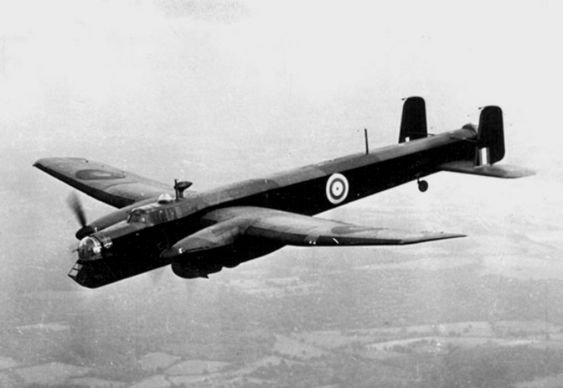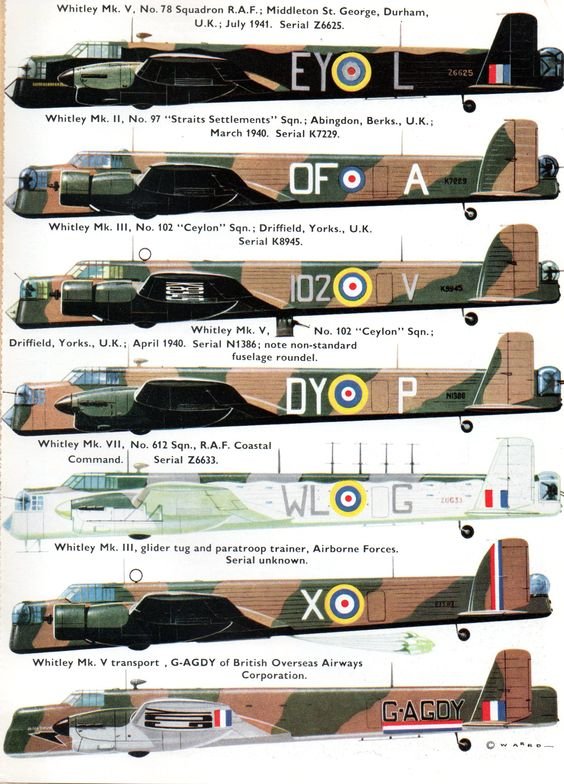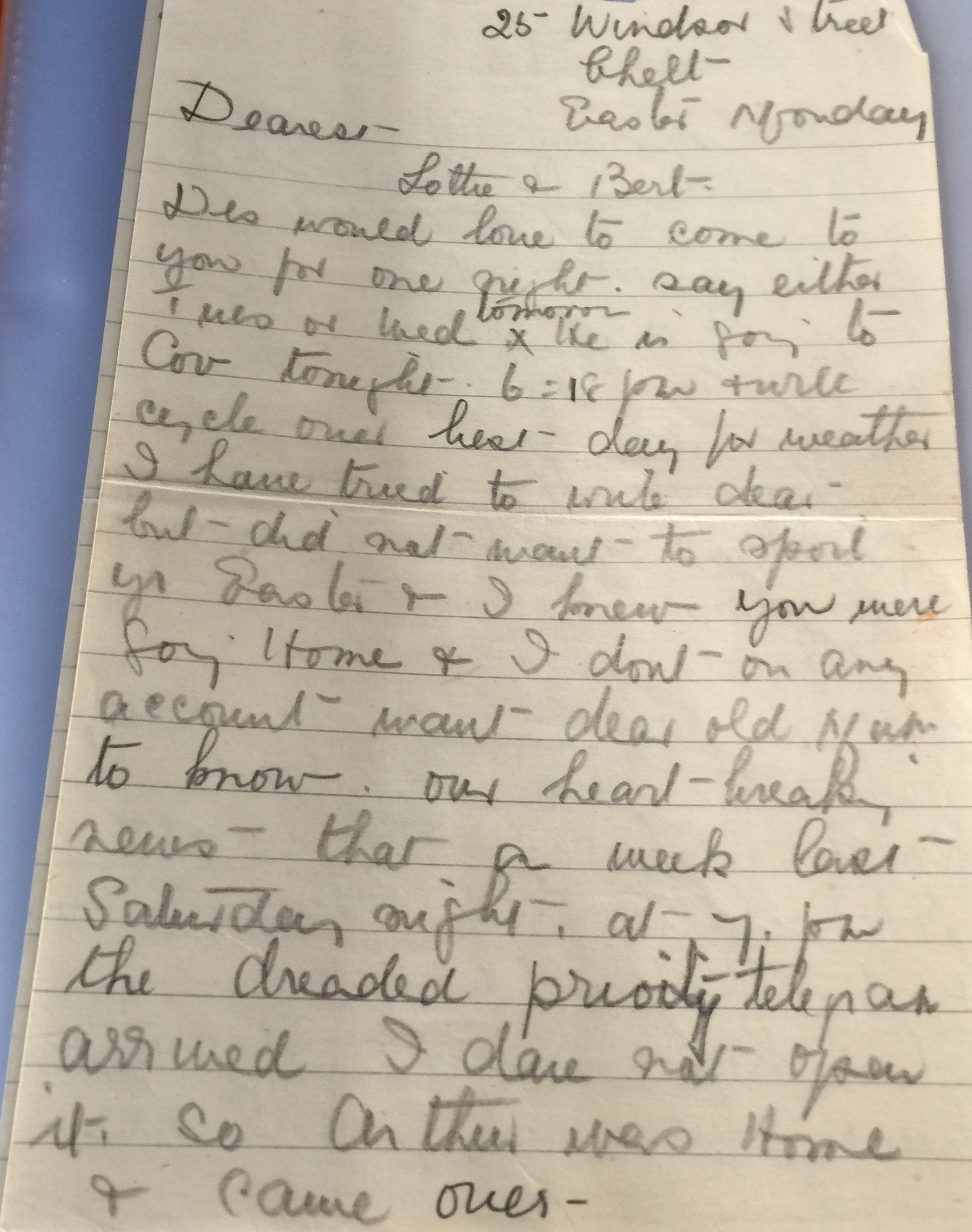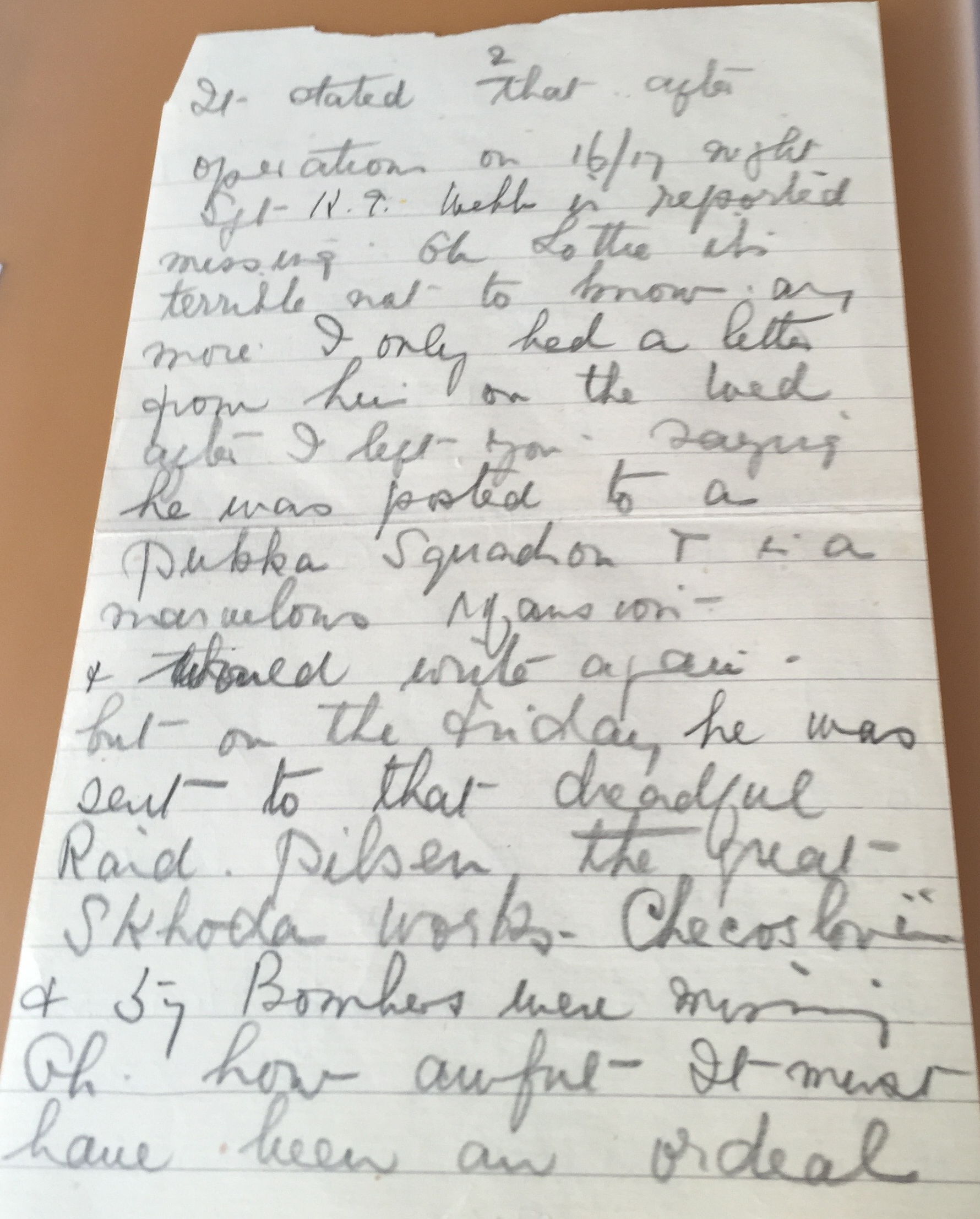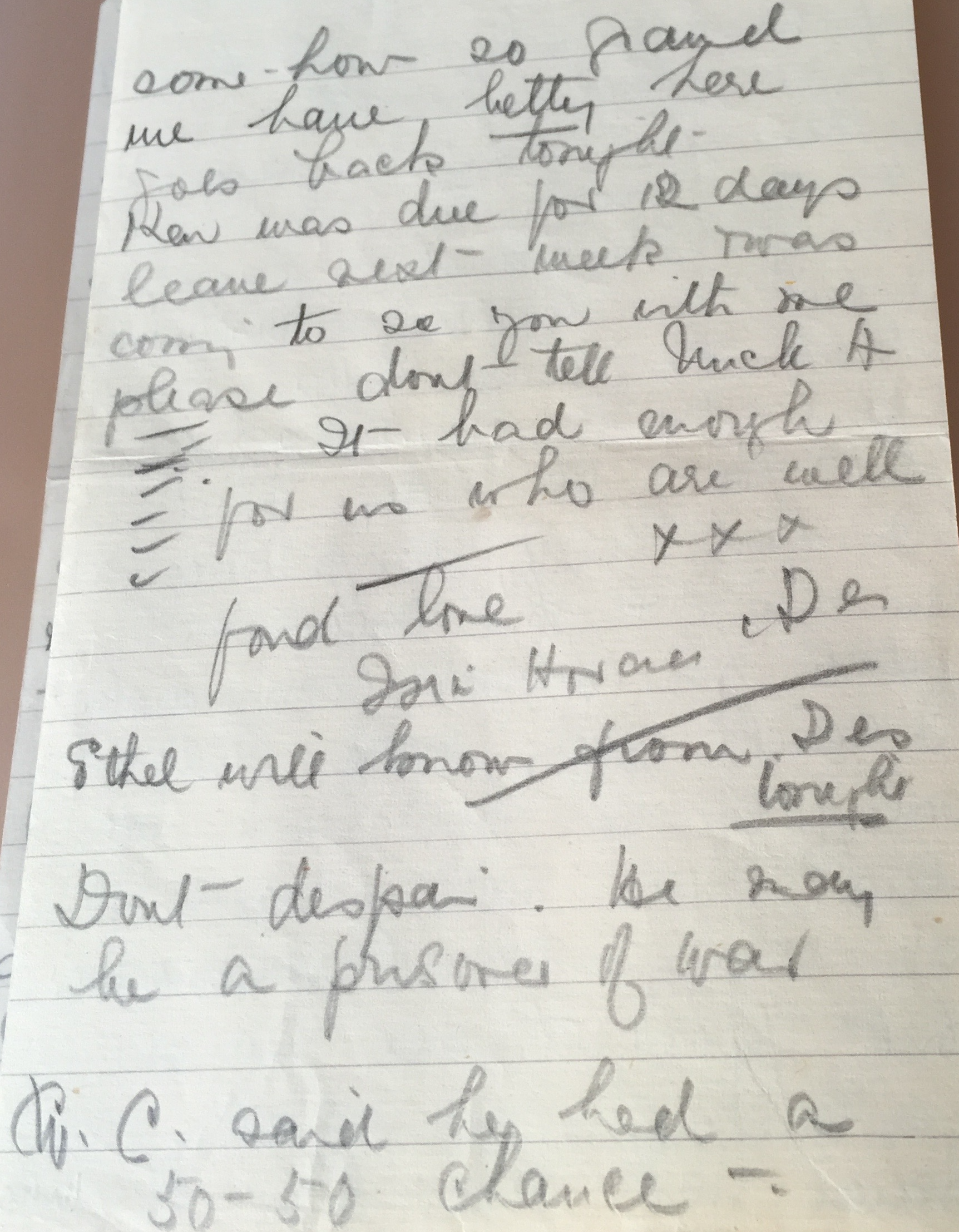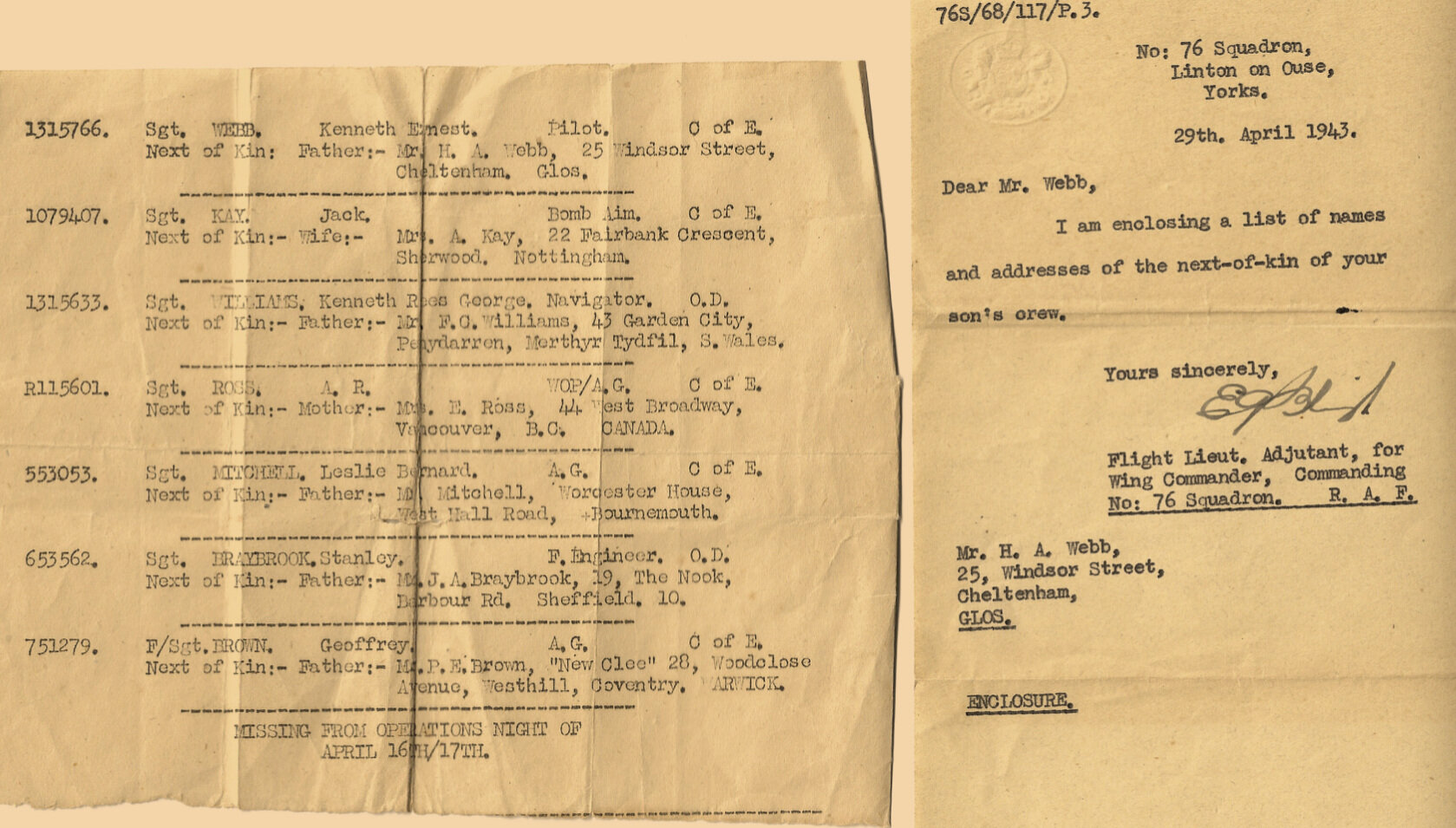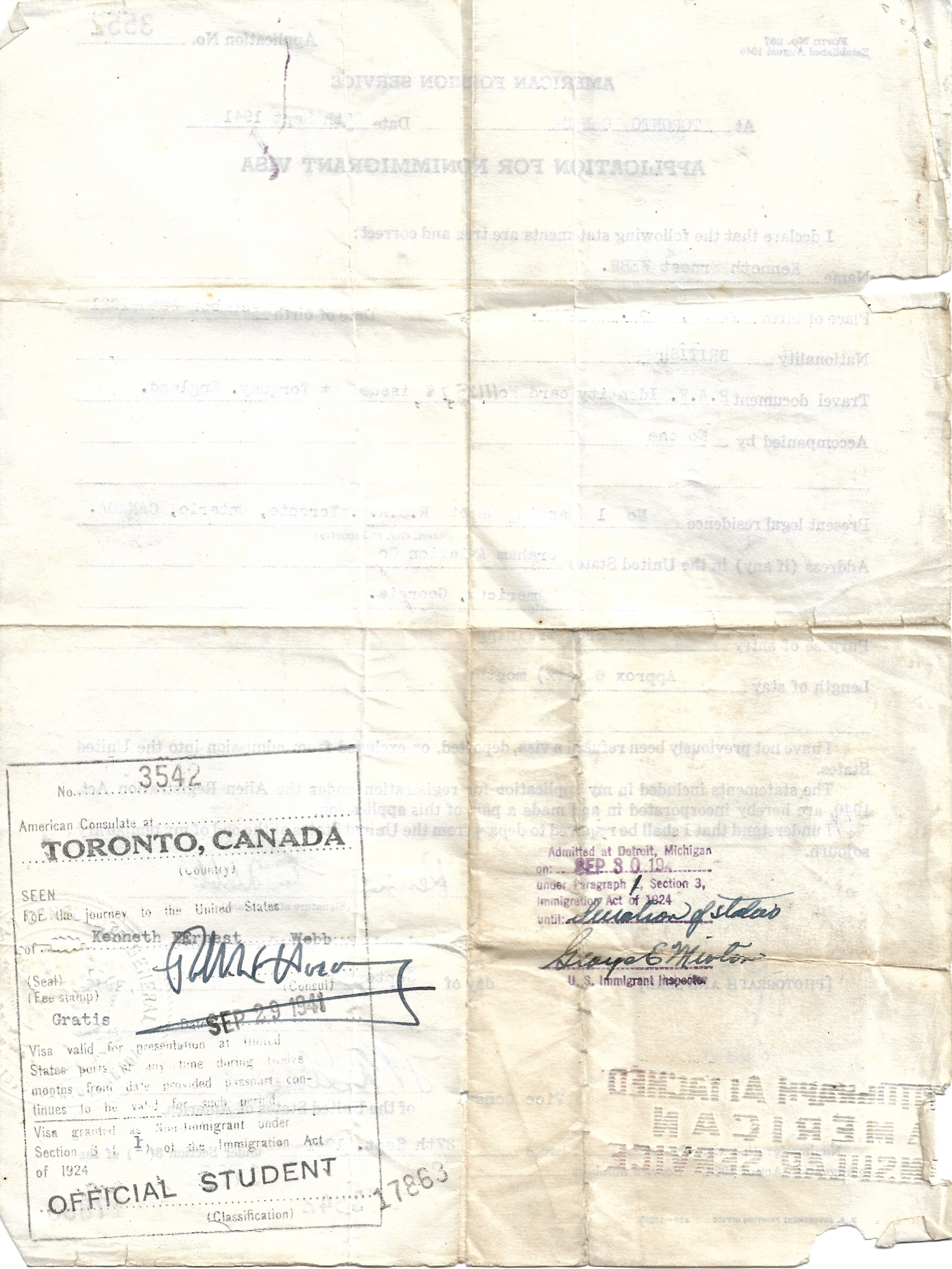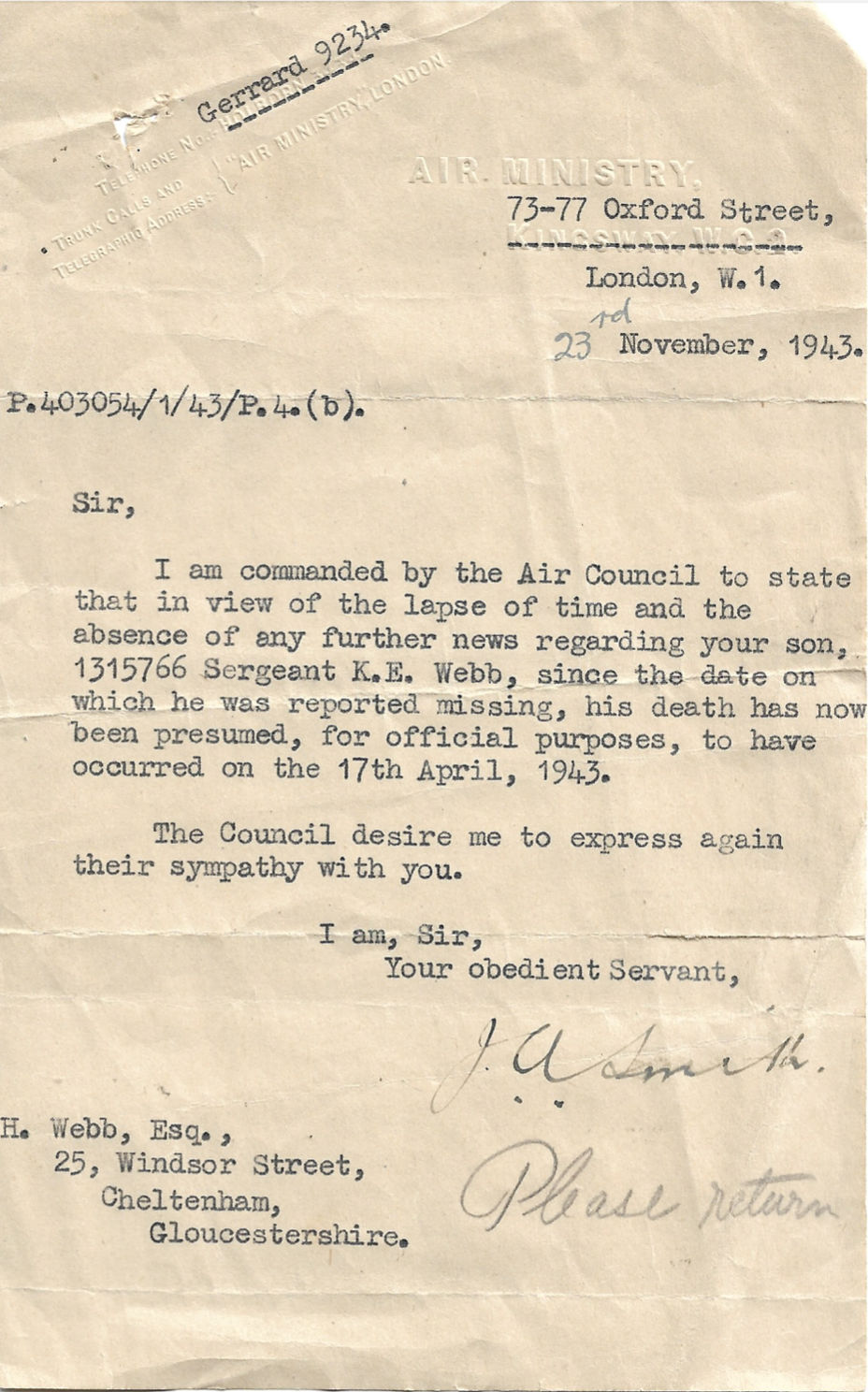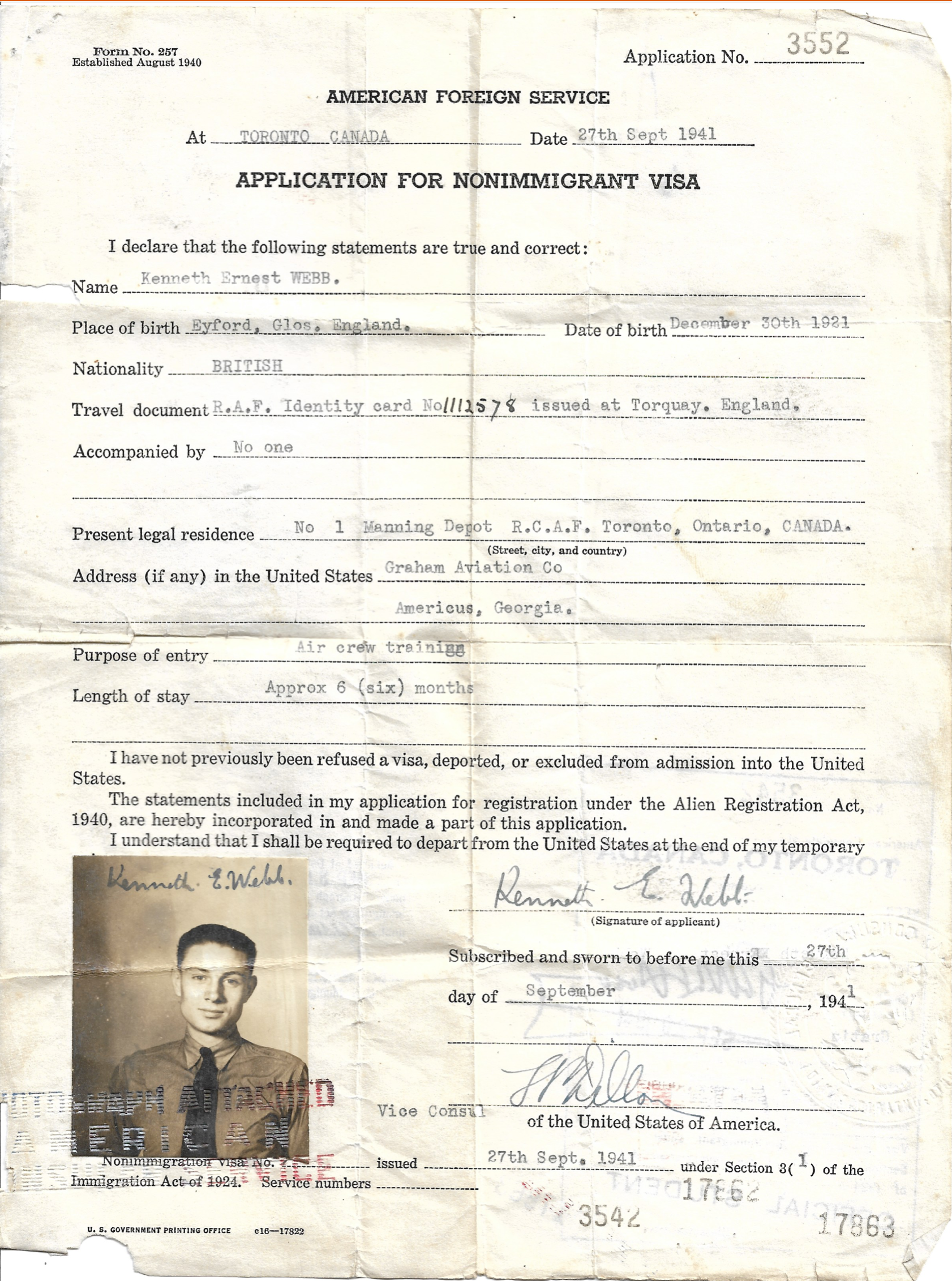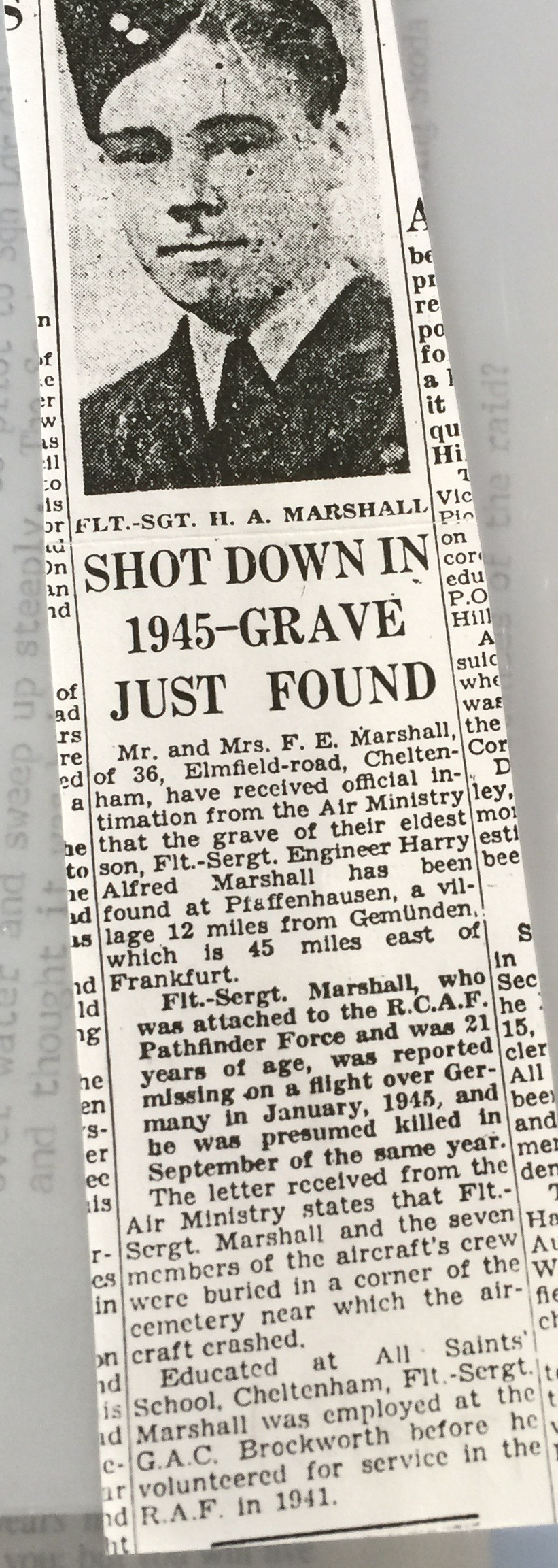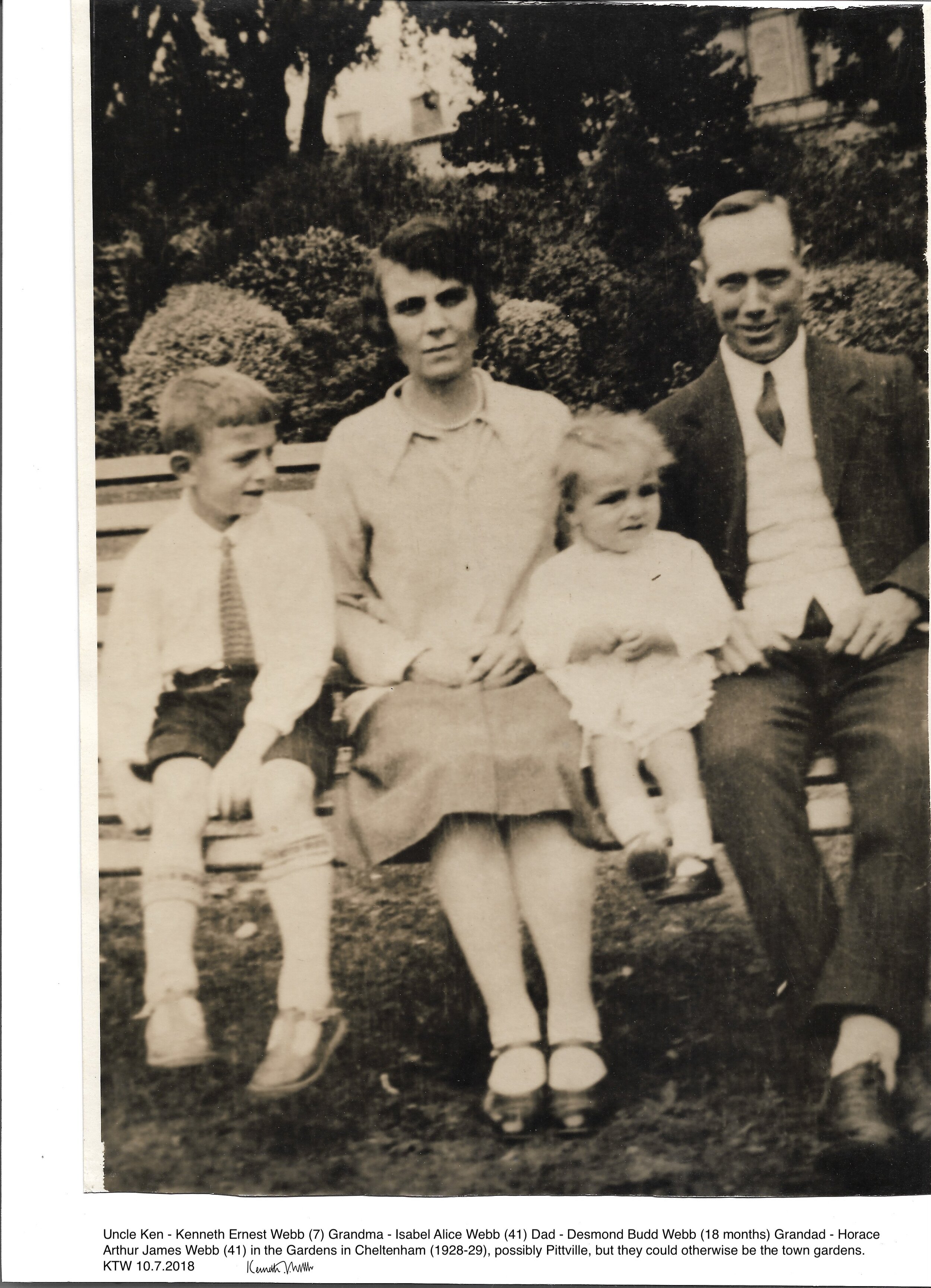WßD ~ Chapter 6 ~ The Dreaded Priority Telegram 1943 (2025 Edition)

Windsor Street Days
Chapter 6
The Dreaded Priority Telegram 1943
The portrait is in pastel by the Artist Hicks of
Kenneth Ernest Webb (Kenneth .E. Webb) aged 20, at RAF Training School, Torquay, Devon, England 1941.
WHEN I FIRST PENNED this chapter, April 17, 2020, it was seventy-seven years on from the same date in 1943.
This Revised Edition is penned two years on.
In archiving, two years is a long time. A table, clear and dusted, can, within a short time, be the home of documents stretching back 300 years. One such document traces this family back 900 years but that is for another chapter.
So, temporarily, Windsor Street Days fast-forwards twenty years from 1923 to 1943.
Later chapters will return to earlier times, but it seems fitting that I should do this, especially given Der Gedenkstein - the Memorial - that now stands in forest-land in Lachen-Speyerdorf, Germany - unveiled and consecrated on Saturday, August 4, 2018.
A family donation has also placed by the Memorial, a bench seat, as the Memorial stands in a small clearing through which a very popular footpath runs, the route for strollers and joggers alike.
Ken - the elder son of Horace and Isabel - had commenced operations in January 1943 with a posting to 10 Operational Training Unit (OTU) RAF St Eval, [1] Cornwall, Coastal Command, flying the Armstrong-Whitworth Whitley Mark X twin-engined bomber. The task was to search for enemy submarines (U-Boats) and also provide cover for allied shipping entering and leaving home waters. The carousel shows the Whitley twin-engined bomber, a model of which now stands behind glass, bearing the markings and serial LS-L Z9278 of the Webb Crew’s Whitley Mk X. Ken’s log book affirms that whilst they were initially engaged in Navigation Exercises and Air Tests, they were primarily engaged in six Anti-Submarine Sweeps, as well as Fighter Affiliation.
Part Two
Spring 1943, sees Ken posted to a heavy conversion unit (HCU) in north-east England, to convert to the four-engined Handley Page Halifax Mk V, taking his crew with him from St Eval, Sergeant Geoffrey Brown (Tail Gunner), Sergeant Kenneth Rees Williams (Navigator) and Sergeant Jack Kay, (Bomb Aimer). From there, they were posted to the renowned 76 Squadron, RAF Linton-on-Ouse in North Yorkshire.[2]
He undertook air ops over Germany as part of the Battle of the Ruhr. Kiel crops up in family correspondence at the time, and also in his RCAF Pilot Log Book.
Then the order came down from the top for a ‘Goodwood’, RAF jargon for “maximum effort” in order to take out the Skoda Works in Plzen, Czechoslovakia, which was now wholly engaged in armaments production for the Nazis.
At this point, it is very important to remember that Czechoslovakia had been occupied by the Nazis, and the civil population did not support Nazi Germany, the country’s industrial capacity being wholly turned over to war production and supplemented with slave labour. Slave-labour policy was to use expertise at minimal cost to the Reich. A person worked on minimum rations until they dropped. If they were not dead, they were sent to one of the death camps for extermination. So it is right to quote here John Nichol in his excellent work Spitfire published by Simon & Schuster in 2018.
Writing in his account of the fighter pilots in the Battle of Britain:
“They were not all from British shores, of course. Some of the toughest came from South Africa, New Zealand, Canada, Australia, and there were also a handful of American volunteers. The fiercest came from those countries already under Nazi thrall: Poles, Czechs, French and Belgians - men with little to lose and a point to prove. This international brotherhood did not flinch from danger. Some favoured charging directly at the enemy, spreading panic through formations. ‘A head-on attack does far more to destroy the morale of the approaching bombers than anything else,’ one bullish pilot advised. ‘It upsets the driver so much, the poor old pilot. He was the chap who turned tail … go straight through the formation, turn round when you get through. And try and have another go from the rear.”
In his contemporaneous wartime journal, David Crook, writing also of the Battle of Britain, records this observation:
“Some squadrons used to do head-on attacks at the bombers, approaching from the opposite direction, firing at them hard in the split seconds as they drew nearer (their aggregate rate of closing being about 55 m.p.h.), and then pull up quickly at the last moment in order to avoid collision. These tactics, carried out with the utmost recklessness and abandon, were generally very successful in destroying some bombers and, more important still, splitting up the formation so that the machines separated, and were then shot down far more easily. Moreover, they rather shook the morale of a number of enemy pilots, and many prisoners, when questioned after capture, said how terrifying they found these attacks.”
War does not differentiate when it comes to targets in occupied countries, as, for example, the French city of Caen was to suffer during the allied invasion of Normandy in June 1944. Because of fierce German resistance, Caen was reduced to ruins by the Allies, and twenty-thousand civilians lost their lives. This gives the harshest reality that razor-sharp edge of just two words one phrase: total war.
The links that appear at the end of this chapter are the avenue one might wish to stroll, to other parts of this website that report comprehensively on the April 16-17, 1943 Plzen Raid.
Part Three
Every family, on all sides, suffers the same reaction upon arrival of “the dreaded priority telegram”.
The War in Ukraine is equally vicious and President Zelenskyy and the Ukrainian People find themselves, unbelievably, caught between two foul men, one Russian, the other American, the latter leaving the former POTUS title now relegated to the gutter.
Chapter Four shows an image of two families, now become one, at the wedding of Des Webb and Nancy Marshall on April 2, 1949, at St Peter’s Church, Tewkesbury Road, Cheltenham. Two people are missing, Ken Webb and Harry Marshall. Neither knew each other, but both served in Royal Air Force Bomber Command, one a pilot, the other a flight engineer-pathfinder in the elite Path Finder Force of 8 Group, RAF Bomber Command.
One can imagine, with the mind’s eye, their profiles slowly erasing, or slowly appearing, depending on whether one is a glass half-full or glass half-empty person.
My point is simpler.
Had it not been for their sudden departures in 1943 and 1945 respectively, this wedding might never have been, this relationship might never have started. My parents often commented on this. Each found in the other, sensitivity and an understanding that both were harbouring, the intense loss of their brothers. Common ground. All I can say to that is, Thank God! And I know that this was the sentiment of Ken’s and Harry’s parents too.
“The Dreaded Priority Telegram” was the very brief telegram that would have been received on April 17/18 direct from RAF Linton-on-Ouse, North Yorkshire, followed up by this formal letter sent out on April 20, by RAF Records, the letter being signed by Flying Officer R Williamson RAF on behalf of the Air Commodore Air Officer Commanding RAF Records, at RAF Innsworth, Gloucester, Gloucestershire.
A hint of the steel …
is caught sight of … for me, this photograph is extraordinary.
Suzie, the Great Niece of Sergeant-Pilot Kenneth Ernest Webb RAFVR with Jason on their Betrothal on a very special day in Hampshire in July 2021. My sisters and I would all agree, that in knowing Dad and his eldest brother, Uncle Arthur, their brother Ken would have mightily approved … and the family branches still catch ‘A hint of steel …’ 78 years on.
Part Four
A hint of the steel - the hallmark of the British People at that time - is caught sight of.
One sees the resolve, the determination, and whilst my paternal Grandfather is his usual jovial self, my maternal Grandfather is determined, resolute, and one who, bluntly, had had a rough hand dealt: the loss of two daughters in infancy, and two sons, one by drowning at Wainlodes on the River Severn, aged 12, in July 1939, and the eldest in 1945 killed in action.
In the First World War he and his elder brother, Harry (also on the 1911 Census listed as Henry) had been captured, and eventually found each other in the same POW Camp; but only my grandfather survived, and his brother Harry died in the camp on October 24, 1918, eighteen days before that previous world war’s end.
Their eldest brother Frederick, at present, little is known of him, but he too - a Volunteer - did not survive, and family records will be updated when Frederick is finally traced. His small Bible beautifully inscribed by him in ink ‘Frederick Marshall 1906’ is within the Family Archive. Let it be emphasized to any reader: this was very much par for the course in the twentieth century, and many families suffered far more.
Likewise, they nevertheless, rallied.
The photograph causes me also to look at my paternal Grandmother, when I recall my father’s account of the Friday morning after the Coventry Blitz on November 14-15 1940, just over eight years earlier.
Isabel caught the express train to Coventry - a direct line between Cheltenham and Coventry in those days - with my father (Desmond 13) - to check up on her brother and sister-in-law and family, our great uncle and aunt, Arthur and Ethel Budd. As Dad often recalled, the smoke, the smell of the bombs, catching a glimpse between warehouse planking of stacked rows of long, plain wooden boxes, more than four hundred. A lasting impression engraved upon the mind of a thirteen-year-old, especially that figure: “four hundred”.
No sooner had the news of the raid reached Windsor Street, than mother and youngest son were on the earliest available train. It gives, too, a hint of the reason why this country resisted and, eventually, defeated evil. And I can see this so clearly in this pictorial of two families becoming one.
Part Five
LET US now leave 1940, and wind the reel on 18 months to 1943. Easter to be exact.
The Telegram that everyone lived in fear of, was brought to the door of 25 Windsor Street. The Royal Air Force was extraordinarily efficient in this regard, more so than the other two services, and the initial telegram would have been received on the evening of Saturday, April 17.
At this time, Number Twenty-Five was also home to Isabel’s mother - Mrs. Eliza Ann Budd neé Wimbush (1851-1948) who had moved in before the war and indeed survived the war, departing at age 96; quite a record for those days. I mention ‘Grannie Budd’ because I realize how difficult it must have been for Grandma to carry on as if nothing had happened … just one line in her letter in pencil on page 2 sums up the closeness, the family unity that was the hallmark of the Webb Family:
… & I don’t on any account want dear old Mum to know our heart-breaking news …
Grandma always wrote with her Parker Fountain Pen, yet writers know too well that there are times when the leaded pencil moves much faster. My own family always has a giggle, even now, when visiting my home … an array of sharpened pencils in every room … Indeed, Carol commented only recently on the recollection that Grandma Webb always had a pencil to hand for her homework, whereas at our home, our monthly expenses did not stretch to an endless supply, leaving Mum searching for that elusive pencil, all too often, I’m sure, ‘borrowed’ by me or our younger sister Vanessa.
Part Six
Rather than write, permit me to place here the transcript I typed out when I first found this letter in 2017 in the family archive. Letters and documents from the past never lose their emotion. Home, here, was very silent that evening and the day following … It was almost as if I had stepped through Time’s window into a scene of tragedy.
Everything about Windsor Street came rushing to the fore: the texture of the carpeting, the seats, the throw-overs, the smooth circular dining table, the old Victorian battle paintings of Balaclava, the oil painting of an erupting Mount Vesuvius (still in the archive); the slow, rhythmic sound of the clock, the back yard, the dog bowl in the kitchen, the art-deco kitchen dresser, the shiny tiled flagstones between the dining room and kitchen, stopping at the three steps that took us up into the front hall; the piano in the front room, the wonderful smell of Freesias, Isabel’s favourite … for the house remained unchanged, even the wartime blackout blinds were still in place, and on the piano was Churchill’s famous framed tribute on behalf of the nation to The Few … I still have it now, and it was certainly in place in the front room from 1941 onwards, along with the framed photographs of all Ken’s crew following on not long afterward in 1943.
Part Seven
The Transcript
25 Windsor Street
Cheltenham
Easter Monday
Dearest
Lottie & Bert
Des would love to come to you for one night. Say either Tue or Wed ^tomorrow..^ he is going to Cov [Coventry] tonight 6:18pm and will cycle over best day for weather.
I have tried to write dear – but I did not want to spoil your Easter & I know you were going Home & I don’t on any account want dear old Mum to know our heart-breaking news – that a week last Saturday night, at 7pm the dreaded priority telegram arrived I dare not open it. So Arthur was Home & came over – [from Number Twenty]
Page 2
It stated that after operation on 16/17 night Sgt K.E.Webb is reported missing. Oh Lottie it’s terrible not to know any more. I only had a letter from him on theWed after I left you – saying he was posted to a pukka Squadron & in a marvelous Mansion [Beninborough Hall] – & would write again – but on the Friday he was sent to that dreadful Raid. Pilsen the great Skoda Works, Czechoslovakia & 57 Bombers were missing. Oh how awful – It must have been an ordeal
Page 3
I have shoals of letters from all who knew him [unreadable] shall see them when we meet again - & one from his Wing Commander – saying what a difficult and arduous task he was given as Pilsen was his task target but from the very first I had every confidence in him & his crew & also his flight commander.
I can’t say more dears only if he has gone forever – we all have so many sweet memories but poor Horace said yesterday we shall never get over this. He was somehow so grand. We have Betty [i] here goes back tonight.
Ken was due for 12 days leave next week twas coming to see you with me. Please [underlined six times] don’t tell ???? A It bad enough for us who are well
XXX
Fond love Issie Horace & Des
Ethel will know from Des tonight.
Don’t despair. He may be a prisoner of war.
W.C. [Wing Commander] said he had a 50-50 chance - .
[i] Betty ~ See Part Thirteen
Part Eight
I hadn’t realized that Dad (16) had carried the awful task of going to Coventry on his own to tell Aunt Ethel, the same night that Grandma was writing this letter. It looks like Dad was catching the 6.18 pm Coventry train, on Easter Monday, probably from St James’ Station (what is now Waitrose). He would then have borrowed the bike to cycle from Coventry to Leamington, 11 miles, on a Wednesday.
Post was good, and so Aunt Lottie and Uncle Bert would have received this letter in Leamington Spa almost certainly by the time Uncle Bert got home from work at tea time on Thursday (after Easter Monday), and Dad would have already forewarned them of the news.
Grandma started writing this on Easter Monday. Then later, inserts ‘tomorrow’ next to Wednesday; so would have finished the letter off on Tuesday. Easter Monday was April 26, 1943.
All round, this letter conveys one of the lowest points in the Webb family’s dealing with the consequences of the war.
Part Nine
I imagine the exact same scenario on the evening of January 17, 1945, to Grandma and Grandad Marshall at Number 36, Elmfield Road.
My Mum was at home when the telegram arrived that evening. Grandad read it, and Grandma broke down completely. The last straw. Although the war was still rising to its most violent, ruthless, and grotesque, for so many people, my mother included, surely the war was coming to an end. Paris had been liberated four months earlier, and parts of the Netherlands, too, in September 1944. But the enemy was ruthless in its occupation of Holland so that large parts were not in fact liberated until May 8, 1945, in the Act of Unconditional Surrender.
Over a lifetime, Mum understood this, until Alzheimer’s and Dementia entered the fray. As Mum’s mind retreated further and further back into the war years, I could keep pace with her and explain the inequity of it all, the unfairness, and I’m just thankful my history teacher, Miss Margo Martin, laid the foundations for me in my teenage that meant that History has always been my companion. In those countless conversations, Mum? I’ll put the kettle on. Let’s have a cuppa, hey! | Ah! Now that’s the first sensible thing you’ve said today, Ken … giggling. And I discovered, too, that when, for a short time, about ten minutes, Mum could wear the headphones, Mum sang along with Vera Lynn … but harmonizing! I’d never heard anything so beautiful because Mum was in tune. I caught it on the iPhone and when Caroline, Suzie’s sister, heard it, she too commented on Grandma’s beautiful voice. I admit that whilst I still have the clip, I’ve not yet had the courage to replay it. Bereavement is a process that one never overcomes; rather, one learns to accommodate its ways. It is a very long process.
I have only learned now, reading a newspaper cutting about Uncle Harry dated September 17, 1947, under the photo of Uncle Harry (the same that Mum has on the mantelpiece) under the bold heading:
SHOT DOWN IN 1945 – GRAVE JUST FOUND
That headline reminds me, again, how fortunate Ken’s parents were in being notified in 1943 that Ken and his crew had been buried with full military honours by the Luftwaffe. This was emphasized to me over and over again by two generations, and it came home to me still more, in 2018 when, standing on the very spot where our uncle’s cockpit came to rest, my sisters and I could say thank you to the German People, and in particular to the Luftwaffe senior officer and his wife, and in German. Herr Erik Wieman had indicated to me the very wide arc surrounding where I stood when addressing the Ceremony, that thousands of shattered perspex pieces had been found from the cockpit canopy imploding upon impact.
It reminds me, too, that Harry’s father received a double blow in 1945, one of the reasons why I have had a disdain for ‘officialdom’ throughout four separate lifetime careers. It was talked about often by our mother.
Nancy saw the letter her father wrote to the Air Ministry in reply to a demand to settle their son’s mess bill. As mum put it, ‘Grandad made it clear. He would go to prison rather than pay one penny. And we never heard from them again.’
Administration can so often be insensitive, and I imagine that our grandfather’s reply would have hit home hard, for, in it, Mum explained, her father had decided to remind the Air Ministry that he had been a prisoner-of-war twenty-seven years earlier, and I know this for sure…
When my Grandfather said certain things, one just knew that every word, every syllable, was a deliberately aimed flaming dart at officialdom. Grandad did not suffer fools gladly, nor did my Mum, nor do I.
Part Ten
I’m concluding this chapter, and whilst I know that my family might not see why there is such a connection between me and Ken (and Harry), I carry Ken’s name. I followed in his, and their, footsteps into the R.A.F.
Isabel was a very matter-of-fact lady, not unlike my elder sister. Grandma took things in her stride. Her step was always confident, never faltering, and I used to love the sound of her short heels clicking the flagstones as she walked from the kitchen into the dining room at Number Twenty-Five. In fact, even now, I sometimes hear that same stride in my own step.
Strange how things carry through the generations. I see it in both my sisters too, and it makes me want to do a punch and leap into the air …. “YEESSSSSSS!” I think my body, though, might have other ideas!!!
The wonderful thing is, that I witnessed this in double measure on July 23, 2021, at Stockbridge at the marriage of Suzie and Jason (Vanessa and Steve’s twin-daughter), and I saw it many times that day as ‘we-three’ chatted and caught up, as distant family branches do. And it was grand.
Part Eleven
I remember Grandma recounting to me the night she realized that Ken was not a prisoner-of-war.
You see Ken, Grandad, and I were asleep upstairs.
I woke up. And who should I see?
Your Uncle Ken, standing by the bed, smiling, in uniform
and he said,
“Don’t worry Mum. I’m alright!”
Nothing more. And clearly the family - typically Webb - were skeptical, and I remember Grandma’s mouth set firmly.
The thing is Ken, I KNOW …
My final note on drawing Chapter Seven to a close relates to Horace, Grandad:
… we all have so many sweet memories but poor Horace said yesterday we shall never get over this.
That is true. None of us do. But we do learn to cope with it. The portraits that seemed to put me in touch with life beyond the normal, still have the same effect today. I’m glad they do. And only one expression comes to mind with the cockpit portrait … LIFE IS GOOD!
And it seems to fit a mother’s own view of her son …He was somehow so grand …
Part Twelve
I add this observation from my elder sister who has just read this chapter. Being three years older, my sister had a mature teenage relationship with our Grandmother, so would have seen things and talked of things that I would not have been aware of:
“Thanks, Ken, just finished chapter 7 which I braced myself for even though I know the details.
So well written every time.
I was struck how Grandma was still in initial shock when she signed the ID card
as that was not her normal writing until she was in her 70s.
Also the letter to Aunt Lottie, I could hear Grandma’s voice in her words. x”
Part Thirteen
Betty
Betty is here goes back tonight.
For a very long time, I could never work out why Grandma mentions Aunt Bette as ‘going back tonight’, not least because Aunt Bette and Uncle Arthur lived across the road at Number Twenty Windsor Street.
Earlier this evening, Friday, February 11, 2022, it suddenly dawned upon me, entirely due to the archive work that has been done since the first edition of this chapter was published, that Grandma is using the spelling ‘Betty’ (which was an absolute no-no with Aunt Bette) because Grandma is referring to Ken’s fiancée.
It suddenly adds a whole new angle to the turmoil of a family at war.
Betty Hughes eventually married, and there is a heart-warming account. Betty asked Grandma to accept Ken’s gift of their engagement ring nine years later on the eve of her marriage (around 1952). And this also suddenly clears up my own little boy’s silent wonder … ‘why does Grandma Webb have two engagement rings on either side of Grandma’s wedding ring?’ “Grandma must be ‘posh!’”
I have mentioned in the archive, also, that none of us today has any record of Betty. Then, opening up one of the many boxes that had come from Cleevemount, Aunt Bette, and Uncle Arthur’s former home via a temporary sojourn in the loft at Pittville (my parents’ former home), digging down deep, the last item was the back of a wooden frame. I had never seen it before. In the same instant, I vividly recall surmising … Surely not! Could this be Ken’s Fiancée? And of course, it is. It is a very beautiful photographic portrait and my only reason for not displaying it here is because it would be very wrong to do so, especially, as the archive, as yet, gives me no details as to Betty’s family. There are also four tiny ‘photo booth style photos in a strip’, though at that time photo booths as we know them were still 30 years away in the future.
Part Fourteen
And so I close this chapter, being reminded again of just how important and sensitive all family archival is. This is the guiding principle, the underlying principle of an archive, and I feel this even more so today when I see the lens abused, and lives shattered by those who seek financial advantage, or worse.
In light of Part Nine, and mention of what happened at 36 Elmfield Road on the evening of January 17, 1945, when the equally dreaded priority telegram arrived, it is right to see Grandma, Uncle Harry’s Mum, in later happier times. It is another 17th day of the month, this time June 1972 on the occasion of Grandma’s eldest Granddaughter’s marriage, Carol to Roger.
I always wondered what it was that Grandma is giving Carol; and recently, Carol explained a lucky charm. Wonderful!
Life Goes On … another 17th day … this time, a most happy one for Grandma, and that endures …
20 April 2025
First Edition written on 16-17 April and 24-26 April 2020
This new Edition is dated the 20 April 2025 to reflect the date of the Telegram ~ 20 April 1943 issued by the Royal Air Force Records Office on that date.
… He was somehow so grand …
Part Thirteen
Excerpt from Spitfire by John Nichol pp61-62 published by Simon & Schuster UK Limited 2018-2019
[1] RAF St Eval, North Cornwall, Coastal Command July 1940
Nearby explosions were the only warning mechanic Joe Roddis of 234 Squadron had when a flight of Dornier 17s arrived at dawn over Saint Eval in North Cornwall. He dashed outside with the other mechanics. Incendiaries were flaring dangerously close to the row of eight wooden huts. Then some landed on the roofs. The airmen scrambled up and kicked them off. Roddis felt both terrified and excited. The screaming bombs and flying shrapnel flew through the air. Finally, he was in the war.
The final stick of bombs came in, throwing up soil, flames and debris as they arced across the airfield towards their accommodation. The final bomb struck the last hut along the line. This time they started an inferno that was impossible to escape. Joe looked at his fellow airmen in horror. They all knew who slept in the end hut – the young women who served them tea and sandwiches, always with a smile. Joe felt a sense of nausea creep up to his guts. The NAAFI girls. There was nothing that could be done. Joe watched with both horror and mounting rage as the screams subsided.
[2] RAF Linton on Ouse, North Yorkshire 11-12 May 1941
This was a clear moonlight night - hence the wartime expression “a bomber’s moon” - not unlike today’s expressions now in our vocabulary - ‘lockdown’, ‘social distancing’, ‘restrictions’, ‘keep two meters distance’, ‘the Thursday 8 pm hand-clap. The station was bombed, and one of the heavy hangars was hit, taking out two Halifax bombers and also Station Headquarters, outside the entrance of which now stands a Memorial Stone to all those killed.
Citation lodged with the Archive at RAF Linton on Ouse, North Yorkshire
Sgt Pilot Kenneth Webb was the skipper of Handley Page Halifax DK165 MP-E. His crew were FS Stanley Braybrook Fight Engineer, FS Allen Ross RCAF Wireless Operator, Sgt Jack Kay Bomb Aimer, Sgt Kenneth Rees Williams Navigator, Sgt Leslie Mitchell Mid-upper-gunner and FS Geoffrey Brown Rear gunner. On 16-17 April 1943 they bombed the Skoda Works in Pilsen Czechoslovakia. Over the target, they were caught in searchlights but successfully slipped out of the beams.
On the return flight, they were twice attacked. The first attack was an explosion at the rear, and the pilot, Ken Webb, ordered "Mitch" to go aft to check on the rear gunner Geoff. As he reached aft and saw that most of the turret had gone, Mitch - after the war, to Ken Webb's parents - explained that at that moment there was a terrific explosion amidships immediately beneath the mid-upper turret, breaking the Halifax in half, and he came down in the tail section 'spinning like an autumn leaf'. On the ground, German civilians rescued him from the wreckage. The crash site is located in forestland in Lachen Speyerdorf Germany and a Memorial now stands at the spot where the cockpit came to rest.
The site was located and excavated by permission of the German Government by Herr Erik Wieman and Herr Peter Berkel of IG Heimat Forschung in 2015, the Memorial being consecrated on August 4 2018 when families of the crew attended.
Frau Hedi Kraus also attended along with her younger son Hans. A young girl in 1943, her mother gave permission for her to lay flowers on the graves in the local cemetery, where the crew had been buried by the Luftwaffe with full military honours.
I am Ken Webb's nephew and next of kin, also Ken Webb, and it was an amazing moment when Hedi called out in German, "Please, Ken Webb Junior lay these flowers for Ken Webb Senior and all the crew as I did."
Yes! It was an incredible moment. I also met the son of the late Herr Manfred Watta, who had died shortly before, and who had supplied a drawing, from memory to the excavation team of the crash site on the morning that Manfred had seen it as a boy. Herr Watta went on to become a very successful architect and artist and is survived by his widow and son, Peter.
The operation was a "maximum effort'" comprising a force of 609 aircraft on a split raid between Pilsen and Mannheim, the latter to draw German air defences away from the main-stream heading for the Skoda Works.
54 planes failed to return - a loss of 378 aircrews which, at the time was reported to be the highest single loss of the Strategic Air Offensive.
It is extraordinary that the nephews of the pilot and flight engineer are now good friends who meet regularly since 2017.
Ken Webb
(Kenneth Thomas Webb 209246 Flt Lt RAF VR Rtd)
An entry made 25 April 2020
Author Note
I include Nichol’s quote and also this personal note following my own visit to Linton, to give the reader a hint of a country at war. Whether on the south-west leg of Britain, or the north-east of England, there was, in effect, no hiding place anywhere, whether England, Scotland, Wales or Northern Ireland and all the outer islands, not to mention our Channel Islands under Nazi occupation with the usual deportations either for slave labour or because one happened to be Jewish, Gypsey, mentally or physically disabled, or homosexual. Personnel would have been very aware of the closeness of the enemy … Ken would have been all too aware of the stakes.
Simply put: “Life Goes On.”
Wartime National ID Card issued to Isabel Alice Webb of 25 Windsor Street, Cheltenham on 1 June 1943 by the Office of National Registration and ceased in 1952, due to widespread public resentment. As a police officer, I remember how, as a nation, we prided ourselves, that we Brits did not need ID Cards.
Ken Webb is a writer and proofreader. His website, kennwebb.com, showcases his work as a writer, blogger and podcaster, resting on his successive careers as a police officer, progressing to a junior lawyer in succession and trusts as a Fellow of the Institute of Legal Executives, a retired officer with the Royal Air Force Volunteer Reserve, and latterly, for three years, the owner and editor of two lifestyle magazines in Liverpool.
He also just handed over a successful two year chairmanship in Gloucestershire with Cheltenham Regency Probus.
Pandemic aside, he spends his time equally between his city, Liverpool, and the county of his birth, Gloucestershire.
In this fast-paced present age, proof-reading is essential. And this skill also occasionally leads to copy-editing writers’ manuscripts for submission to publishers and also student and post graduate dissertations.

